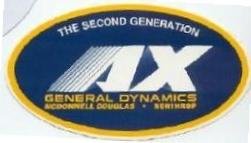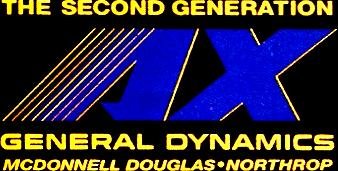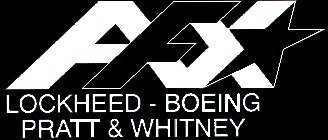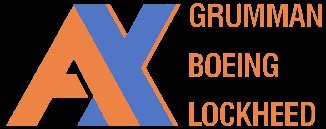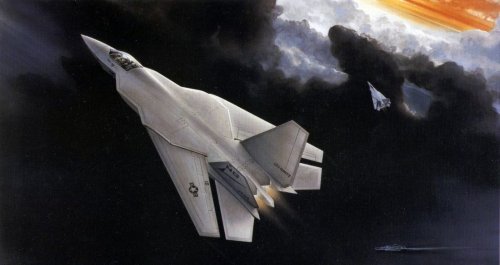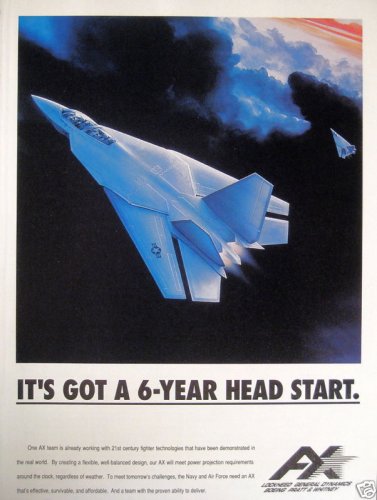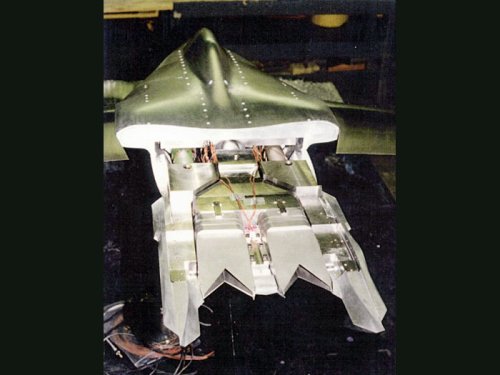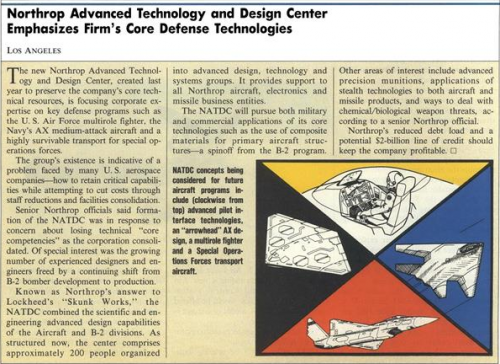F-14D,
Forgive this necroposting breakin but I feel there are problems with your argument that are too multifaceted to ignore:
1. I don't believe the USN did or does know as much about LO as the USAF does.
They certainly didn't during the A-12 program when their approach created massive problems in both resonant dipole and optical scattering areas due to a mis-apprehension that RAM, layered on like the latest layer of linoleum in a 30 year old apartment, could solve for every issue. It doesn't. It never did. It is useful solely as surface coating to help blend discontiguous material junctures and as a deep channel 'circuit' to spread the impedance load around the airframe periphery. The USN broke both of those rules with the straight TE which scattered traveling waves as Rayleigh all across the front sector and with the nose which was so bad with multi-surface junctures around the inlets that they had to affix a bra to it like on a high end sports car. They showed similar errors in judgment with the design of the buried engines and in particular with the exhaust scheme which didn't provide for the active cooling as materials adjustment which LM was doing almost two generations earlier in the F-117. It was, bluntly, a _very bad_ idea to put a lower hemisphere exhaust on a VLO penetrator intended to operate in the heart of the trashfire because the USN flatly refused to believe that stealth could work, out of the clutter. Their experience with the A-6 drove part of this but it was still something which they should have known more of before they dared to set RFP specs for an airframe which was weight critical. Since the Navy was also going the cheap route and insisted the contractors break standing rules (after 1988) for a Fixed Price program by buying in on a spec'd airframe that it was essentially purchasd for 73 million instead of the 130 that even GDM originally requested, it became -essential- for them to kick down compartment doors into the ATB and 117 efforts and the USAF essentially said: "No, I'm bigger." the USN forced the companies to work both the weight reduction and the signatures issue while already in over their head from Concept Formulation onwards with freeby services. This is what put the program out of cost and it was obvious to everyone, including Elberfeld, from the outset, largely because men like Ben Rich were _telling them_ that they were not going to get away with cheap skating.
2. The F-22 is a Fuel Cooled LE airfoild platform.
Which is also Top Coated to shift the IR response into a band which has high attenuation. The IR signature rise of supersonsics derives from the oblique shock which comes off the nose. At Mach 1.4 it's hardly noticeable. By Mach 1.7 it is predominant. Slow Supercruise is still better than subsonics when it comes to both getting to radius quickly withing a given fuel usage. And controlling fight geometry in the intercept phase.
Modern IRST like the PIRATE and ORLS-30 looking up at a hot spot at 60K from 40K 'with no radar return' may well be excused for shooting at the target on-assumption. But the problem is that the target has a dominant F-Pole advantage over them of a dozen miles or more and THEY will be at burner to hold even that much leverage. It's the SR-71 game.
3. The A/FX is inherently flawed in it's design as an SC&M Fighter.
When you retract the wing you drastically change aspect ratio, center of lift and total wing area. This means you effectively can go faster for any given thrust increment but your Ps is going to be in the basement because you are robbing lift and making some bad trades in terms of trim. The F-14 with it's glove vanes (and .6 higher Mach) is an illustration of what you have to do to get a 6G turnoff extension from a VG platform. Even then you are in a winddown condition, not a constant maneuver one.
4. The utility of Supercruise
Doesn't lie in it's mechanical use as a threat avoidance capability. It never did. It's greatest use, especially today where we are facing threats like the Klub and DF-21D, is simply in getting from A to B (1,000nm radii, minimum gas pass tanking) on a given amount of gas without taking 5 hrs, each way, to do it.
Contrary to the popular conception, there is no 'WEZ Bubble' condition-
http://1.bp.blogspot.com/-DeD3FURlcPw/TYRKd9j_i2I/AAAAAAAAC7A/jA6HFDidIeU/s1600/LIBYA%2BALL%2BLAYERS.jpg
It is a single wedge of a TallKing/Nebo/Vostock type system-
http://3.bp.blogspot.com/_0HCJq6B1wZA/SgJm8zs3UjI/AAAAAAAACG0/3YEgIRE6BVk/s400/WEDGESST17.jpg
With all the forward placed sites in an EMCON condition _until engagement_.
You overfly a well designed IADS layout at high Mach and altitude, you are giving weapons like the SA-4/5 let alone SA-10/20/21 easy shots. Because they have the impulse to make the cutoff on anything short of an SR-71 and they are going to use the low band EWR to provide the initial cue signature from a _non emitting_ ambush condition. As you reach your point of closest approach, they will searchlight you with high PRF in a tight beam and, 'LO or no' you are gonna get tracked because the ERPS off a modern EPAR like the Flap Lid or Tombstone are enormous.
Blundering about at intermediate SSC under these conditions is like knights riding across a thicket of hidden punji stick traps. You won't see'em until you are engaged and then they will grow in front of you like Jack's beanstalk.
Which brings me back to argument 3. Because if the A/FX has a compromised set of signature values at anything but full sweep (where all the planform angles align) and it's aerodynamic configuration is such that, at height, it cannot penetrate at more than M=.85, it is NOT going to be either quick enough to goose-thru or sectored-return stealthy enough to ghost-thru.
You cross into the beam at 500knots and <40K and the threat shoots. You break and instantly lose 150 knots as the wings come out. Past which you are a flat plated, conventional signature, target drone with no more EM than a Hornet.
Which should tell you a lot about why the A/FX's weapons bays, far from being as _small as_ those of the Raptor are in fact a minimum of 16 feet (to accomodate the 14ft GBU-24 and 15ft AGM-84E) and 13.5ft long (to accomodate the AIM-120).
Skinning around a weapons bay volume larger than you need to deliver precision gliding or boosted ordnance (MMTD and FOG-S, both in the 6-10ft and <1,000lb class) was a mistake the USN also made on the A-12. One which ended up costing them the program in terms of weight vs. cost issues. I think it significant that the USN was still using LGBs (<6nm at altitude) and standoff missiles (>60nm, turbine powered) as threshold delivery metric rationales for A/FX platform design, as the USAF prepared for a mass-shift towards 2.65m CEP IAMs.
This is not a LO-knowledgeable design driver decision.
CONCLUSION:
As a collectivized argument for or against the A/FX supercruise in an 'otherwise LO' penetrating interdictor, I think it a pretty damning argument against the Navy that they could not see the /how/ of Raptor multi-layered mission performance achievement as being integral to the -why- their own assumptions of integrating the capability within a VG CVTOL platform design was never going to work.
The F-22 has an 840 square foot wing area for a reason. The F119 has a 50% higher SFC than the F100 for a reason. A Raptor pilot can tweak back those monster engines to a dull rumble and not stall out while it 'hovers' at 60K, EMS vacuuming the ether and still have a 30 nm flyout on GBU-53 as an IADS killer at 250KIAS. Or it can gain massive sprint lead from a strike package as presweep time to a BARCAP offset -beyond- the target, giving crucial leverage in the mission persistence as threat reaction window. And finally, as a penetrating interdicator itself, it can treat radials as leg segments which allows it to make 1hr transits from an A2AD protected base to tank well beyond the fence, fly another 300nm into the target area and back, gas up again and be home in another hour. Across an 1,100nm total radius. Try that in an F/A-18E/F or an A/FX and you will have AfG mission times on the order of 10-12rs. Minimum.
Subsonic VG doesn't give you LO with carrier capability because VG adds enormous weight and CG penalties of it's own which functionally takes away supercruise -as heighting- (thrust minus drag) automatically.
Even as the residual subsonic envelope (<40K, <1.2M) you are left with inevitably means you are transiting emitter lines at such slow-low numbers that you are bound to be picked up when you pass through your optimized front-sector protected cone. This in turn means that, whatever the optimum planform sweep alignment, the defenses will see you long enough to get the lock and when they do, your wings will be coming full forward to try and put more area under lift because the baseline area of a VG straight airfoil is just too small when swept to be useful. And thus any evasion at all has you bleeding E and mirroring a wider return aspect like a chrome plated stuck pig.
The F-22 wins in all three areas of thrust trust, optimized LO and optimized lift because it takes all three together to ghost through, high-fast, and keep the engagement window narrow enough to prevent the threats from forcing the evasion which brings you down into their ideal engagement envelope.
LEG

